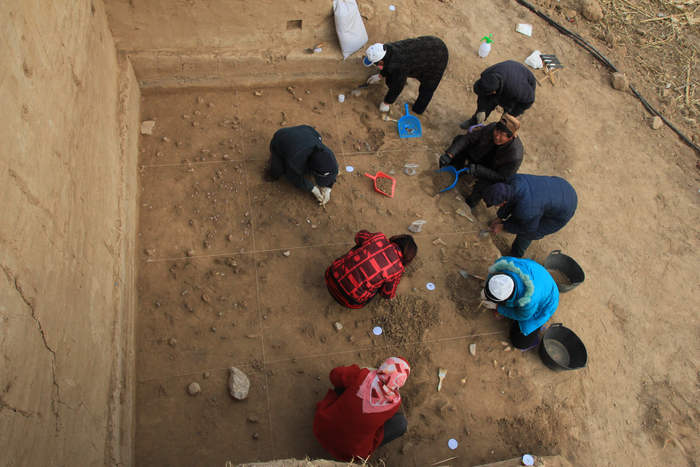The Independent's journalism is supported by our readers. When you purchase through links on our site, we may earn commission.
Archaeologists unearth evidence of ‘innovative’ Stone Age culture from 40,000 years ago in China
People of ancient culture demonstrated ‘complex technical system’ for transforming raw materials, scientists say

Your support helps us to tell the story
From reproductive rights to climate change to Big Tech, The Independent is on the ground when the story is developing. Whether it's investigating the financials of Elon Musk's pro-Trump PAC or producing our latest documentary, 'The A Word', which shines a light on the American women fighting for reproductive rights, we know how important it is to parse out the facts from the messaging.
At such a critical moment in US history, we need reporters on the ground. Your donation allows us to keep sending journalists to speak to both sides of the story.
The Independent is trusted by Americans across the entire political spectrum. And unlike many other quality news outlets, we choose not to lock Americans out of our reporting and analysis with paywalls. We believe quality journalism should be available to everyone, paid for by those who can afford it.
Your support makes all the difference.Researchers have unearthed features of a “unique” and “innovative” 40,000-year-old Stone Age culture in China with the earliest known evidence of ochre processing in eastern Asia.
The findings from the archaeological site at Xiamabei in the Nihewan Basin in northern China shed light on human lifestyle in east Asia tens of thousands of years ago, scientists, including those from the Chinese Academy of Sciences in Beijing, said.
Although earlier research has established that humans arrived in northern Asia about 40,000 years ago, scientists have said that important details about their lives and cultural adaptations, as well as their interactions with cousin human species like Neanderthals and Denisovans, remain unknown.
In the latest study, published on Wednesday in the journal Nature, scientists described new findings from the well-preserved archaeological site, including the earliest known ochre-processing feature in east Asia, a distinctive miniaturised stone assemblage with bladelet-like tools bearing traces of hafting, and a bone tool.
“Xiamabei stands apart from any other known archaeological site in China, as it possesses a novel set of cultural characteristics at an early date,” study co-author Fa-Gang Wang from the Hebei Provincial Institute of Cultural Relics and Archaeology, whose team first excavated the site, said in a statement.
At the site, scientists found evidence of extensive use of ochre by the ancient culture, as shown by artefacts used to process large quantities of pigment.
These artefacts, they said, included two pieces of ochre with different mineral compositions and an elongated limestone slab with smoothed areas bearing ochre stains, all on a surface of red-stained sediment.
Further analysis indicated that different types of ochre was brought to Xiamabei and processed through pounding and abrasion to produce powders of different colour and consistency, the use of which impregnated the habitation floor. Seven of the stone tools used in the process showed clear evidence of hafting to a handle.
The analysis also suggested that some tools were used for boring, hide scraping, whittling plant material as well as cutting soft animal matter.
They said the blade-like stone tools at Xiamabei were unique for the region, with a large majority of them being miniaturised, more than half measuring less than 20mm.
The ancient people of this Stone Age culture demonstrated a complex technical system for transforming raw materials not seen at older or slightly younger sites, the researchers said.
Based on the stone tools as well as other cultural evidences from the site, scientists speculate that the people in the region lived a hunter-gatherer lifestyle 40,000 years ago in a cool, steppe-like environment.
They may have conducted activities around a warm campfire, grinding large quantities of ochre powder, hafting blade-like stone tools to conduct a variety of tasks such as hide and plant processing, and, most likely, sharing food, including the meat they hunted, researchers said.
The findings also provided insights into the toolmaking industry during this key transition period in human history.
Although no human remains or those of their cousin species were found at Xiamabei, the presence of modern human fossils at the contemporary site of Tianyuandong and the slightly younger sites of Salkhit and Zhoukoudian Upper Cave suggested visitors to Xiamabei were Homo sapiens, researchers said.
But the jury is still out on this, as scientists said the role of archaic human cousin species Denisovans and Neanderthals cannot be excluded.
“The cultural assembly of traits at Xiamabei is unique for Eastern Asia and does not correspond with those found at other archaeological site assemblages inhabited by archaic populations or those generally associated with the expansion of Homo sapiens,” scientists wrote in the study.
Due to the unique nature of the latest findings, they said the archaeological record does not fit with the idea of continuous cultural innovation, or of a fully formed set of adaptations that enabled early humans to expand out of Africa and around the world.
Instead, archaeologists said there could be a “mosaic of innovation patterns”, with the spread of earlier innovations, the persistence of local traditions, and the local invention of new practices all taking place in a transitional phase.
“Our findings show that current evolutionary scenarios are too simple, and that modern humans, and our culture, emerged through repeated but differing episodes of genetic and social exchanges over large geographic areas, rather than as a single, rapid dispersal wave across Asia,” Michael Petraglia, another co-author of the study from Max Planck Institute in Jena, said.
Join our commenting forum
Join thought-provoking conversations, follow other Independent readers and see their replies
Comments